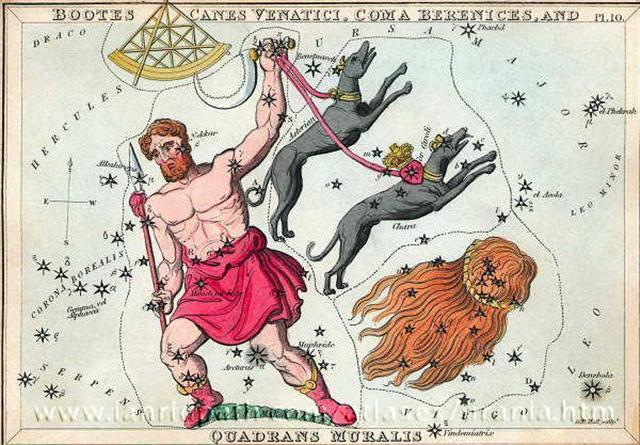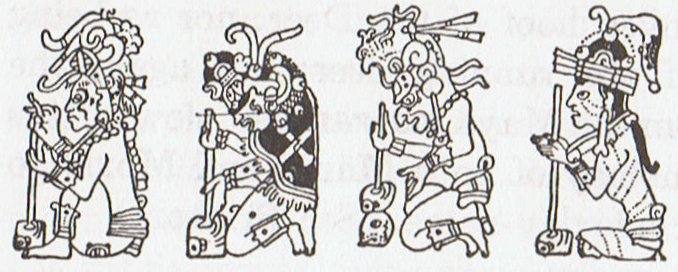219. The Smith (Ilmarinen) could have begun his work in creating Sampo (Barker's Mill so to say) in April 1:
However, he needed another triplet of days in order to get his time (timing) in order: "The next three days his servants keep working the bellows. On the first day of their labour // He himself, smith Ilmarinen, // Stooped him down, intently gazing, // To the bottom of the furnace, // If perchance amid the fire // Something brilliant had developed. From the flames there rose a crossbow, // Golden bow from out the furnace; // 'Twas a gold bow tipped with silver, // And the shaft shone bright with copper. And the bow was fair to gaze on, // But of evil disposition // And a head each day demanded, // And on feast-days two demanded, // He himself, smith Ilmarinen, // Was not much delighted with it, // So he broke the bow to pieces, // Cast it back into the furnace. The next day, Ilmarinen looks anew, And a boat rose from the furnace, // From the heat rose up a red boat, // And the prow was golden-coloured, // And the rowlocks were of copper. And the boat was fair to gaze on, // But of evil disposition; // It would go to needless combat, // And would fight when cause was lacking, Ilmarinen casts the boat back into the fire, and on the following day he gazes anew at the bottom of the furnace, And a heifer then rose upward, // With her horns all golden-shining, // With the Bear-stars on her forehead; // On her head appeared the Sun-disc. And the cow was fair to gaze on, // But of evil disposition; // Always sleeping in the forest, // On the ground her milk she wasted. Therefore did smith Ilmarinen, // Take no slightest pleasure in her, // And he cut the cow to fragments, // Cast her back into the furnace. The fourth day: And a plough rose from the furnace, // With the ploughshare golden-shining, // Golden share, and frame of copper, // And the handles tipped with silver. And the plough was fair to gaze on, // But of evil disposition; // Ploughing up the village cornfields, // Ploughing up the open meadows, Therefore did smith Ilmarinen // Take no slightest pleasure in it. // And he broke the plough to pieces, // Cast it back into the furnace, Called the winds to work the bellows // To the utmost of their power. // Then the winds arose in fury, // Blew the east wind, blew the west wind, // And the south wind yet more strongly, // And the north winds howled and blustered. Thus they blew one day, a second, // And upon the third day likewise. // Fire was flashing from the windows, // From the doors the sparks were flying // And the dust arose to heaven, // With the clouds the smoke was mingled. Then again smith Ilmarinen, // On the evening of the third day, // Stooped him down, and gazed intently // To the bottom of the furnace, // And he saw the Sampo forming, // With its many-coloured cover." How should we count? The servants of Ilmarinen worked the bellows for 3 days but then on the 4th day the smith called out for help from the 4 winds. These blew furiously for another triplet of days and at last, on the evening of the 3rd day the Mill with its rainbow cover was beginning to form. From the beginning of April to its day 3 + 3 will bring us to day 96 (= 384 / 4) counted from January 1. Or to day 107 counted from December 21. This was 16 days after the heliacal position of Sirrah at 0h and therefore she would return to visibility in April 6. And at the other side of the sky was Coma Berenices and Virgo:
The Chinese counted with 3 days of cold food and with 5-6 days to reach the day of the renewal of fire: ... In China, every year about the beginning of April, certain officials called Sz'hüen used of old to go about the country armed with wooden clappers. Their business was to summon the people and command them to put out every fire. This was the beginning of the season called Han-shih-tsieh, or 'eating of cold food'. For three days all household fires remained extinct as a preparation for the solemn renewal of the fire, which took place on the fifth or sixth day after the winter solstice [Sic!] ... This has to mean those 3 days of eating cold food defined their winter solstice:
The ceremony was performed with great pomp by the same officials who procured the new fire from heaven by reflecting the sun's rays either from a metal mirror or from a crystal on dry moss. Fire thus obtained is called by the Chinese heavenly fire and its use is enjoined in sacrifices: whereas fire elicited by the friction of wood is termed by them earthly fire, and its use is prescribed for cooking and other domestic purposes ... Like archaic China and certain Amero-Indian societies, Europe, until quite recently, celebrated a rite involving the extinguishing and renewal of domestic fires, preceded by fasting and the use of the instruments of darkness. This series of events took place just before Easter, so that the 'darkness' which prevailed in the church during the service of the same name (Tenebrae), could symbolize both the extinguishing of domestic fires and the darkness which covered the earth at the moment of Christ's death. In all Catholic countries it was customary to extinguish the lights in the churches on Easter Eve and then make a new fire sometimes with flint or with the help of a burning-glass. Frazer brings together numerous instances which show that this fire was used to give every house new fire. He quotes a sixteenth-century Latin poem in a contemporary English translation, from which I take the following significant lines: On Easter Eve the fire all is quencht in every place, // And fresh againe from out the flint is fecht with solemne grace. Then Clappers cease, and belles are set againe at libertée, // And herewithall the hungrie times of fasting ended bée ...
|
||||||||||||||||||||||||||||||||||||||||||||||||||||||||||||||||||||||||||||||||||||||||||||||||||||||||||||||||||||||||||||||||||||||||||||||||||||||||||||||||||||||||||||||||||||||||||||||||||||||||||||||||||||||||||||||||||||||||||||||










